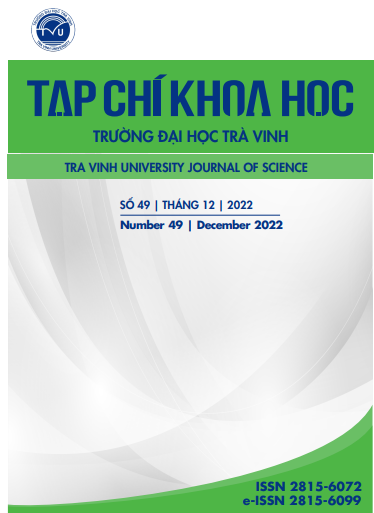FORMULATION AND EVALUVATION OF SKIN CREAM WITH NANO SILVER SYNTHESIZED FROM PASSION FRUIT PEEL
Main Article Content
Abstract
Nano-silver technology for cosmetics preparation is quite popular in recent times because nano-silver is non-toxic and has good antibacterial properties used to create products for skin protection purposes. This study
investigated the preparation of a cream product that brings a moisturizing effect with hyaluronic acid and antibacterial effects with nano-silver extracted from natural, environmentally friendly passion fruit peels. The product not only meets the market demand but also brings outstanding efficiency in the application of the antibacterial properties of nano-silver to users. This study investigates the excipient ingredients to prepare
a complete formula cream containing nano-silver with antibacterial and skin moisturizing properties. The nano-silver lotion formula was developed by evaluating the ability of excipient emulsions including oil phase - water phase excipients, emulsifying excipients, excipients with moisturizing effect, and the ratio of nano-silver.
After that, the cream was evaluated for sensory, pH, skin irritation, moisturizing ability, and antibacterial ability on some strains of bacteria. The study was success in preparing a moisturizer containing nano-silver synthesized from passion fruit peel extract, satisfying the properties of a cosmetic product and encouraging further research.
Downloads
Article Details
References
cosmetics. Journal of Cosmetics, Dermatological Sciences and Applications. 2016;6(1): 48–53.
[2] Campbell CSJ, Contreras-Rojas LR, DelgadoCharro
MB, Guy RH. Objective Assessment of nanoparticle
disposition in mammalian skin after topical exposure.
Journal of Controlled Release. 2012;162: 201–207.
[3] Nguyen TMT, Nguyen TAT, Tuong-Van Pham N, Ly
QV, Tran TTQ, Thach TD, et al. Biosynthesis of
metallic nanopartcles from waste Passiflora edulis
peels for their antibacterial effect and catalytic activity. Arabian Journal of Chemistry. 2021;14(4): 2–13.
[4] Trần Quốc Hùng, Nguyễn Hồng Trang. Nghiên cứu
bào chế kem dưỡng da có chứa hoạt chất quercetin.
Tạp chí Y Dược học, Trường Đại học Y Dược
Huế. 2016;Số đặc biệt: 258–266. [Tran Quoc Hung,
Nguyen Hong Trang. Formulation of moisturizing
cream containing quercetin. Journal of Medicine and
Pharmacy - Hue University of Medicine and Pharmacy. 2016;Special issue: 258–266].
[5] Vũ Đức Lợi, Lê Thị Thu Hường, Bùi Thanh Tùng,
Bùi Thị Xuân. Phát triển sản phẩm trắng da chống
nám từ nguồn nguyên liệu thiên nhiên Việt Nam. Tạp
chí Khoa học Đại học Quốc gia Hà Nội: Khoa học
Y Dược. 2018;34(2): 31–42. [Vu Duc Loi, Le Thi
Thu Huong, Bui Thanh Tung, Bui Thi Xuan. Development of functional food products and skin bleaching
cosmetics from Vietnamese natural sources. VNU
Journal of Science: Medical and Pharmaceutical
Sciences. 2018;34(2): 31–42].
[6] Juncan AM, Moisă DG, Santini A, Morgovan C,
Rus LL, Vonica-T, incu AL, et al. Advantages of
Hyaluronic Acid and its combination with other
bioactive ingredients in cosmeceuticals. Molecules.
2021;26(15): 44–29.
[7] Bộ Y tế. 3113/1999. Ban hành tiêu chuẩn giới hạn vi
khuẩn, nấm mốc trong mỹ phẩm, và phương pháp
thử kích ứng trên da thỏ. Việt Nam: Bộ Y Tế;
1999. [Ministry of Health. 3113/1999. Standards for
limits of bacteria, fungi in cosmetics, and methods for
testing skin irritation on rabbits. Vietnam: Ministry
of Health; 1999].
[8] de Oliveira Pinto CAS, Martins TEA, Martinez RM,
Freire TB, Velasco MVR, Baby AR. Vitamin E
in human skin: functionality and topical products.
In: Pınar Erkekoglu and Júlia Scherer Santos (eds).
Vitamin E in Health and Disease - Interactions,
Diseases and Health Aspects. London: IntechOpen;
2021. https://doi.org/10.5772/intechopen.98336.
[9] Phạm Văn Hiền. Da liễu học. Hà Nội: Nhà Xuất
bản Y học – Bộ Y tế; 2009. [Pham Van Hien.
Dermatology. Hanoi: Medical Publishing House -
Ministry of Health; 2009].
[10] ISO 10993 – 10:2010. Biological evaluation of medical device – Part 10: Test for irritation and skin
sensitization. 2010: 6–13.
[11] Vu TH, Bui VH, Nguyen NT. Antibacterial properties
of sliver nanoparticles synthesized using Piper betle
L. leaf extract. Materials Science Forum. 2021;1020: 236–242.
